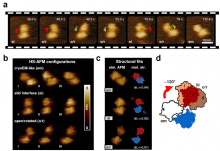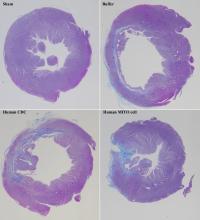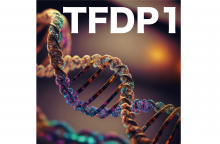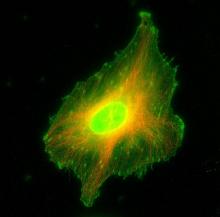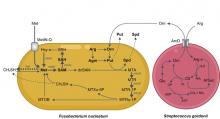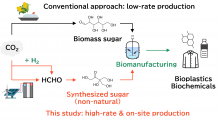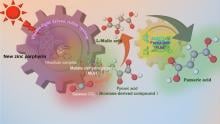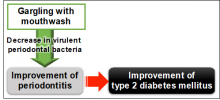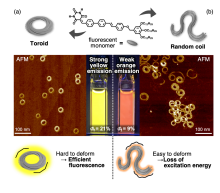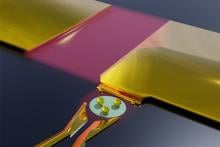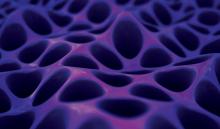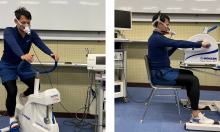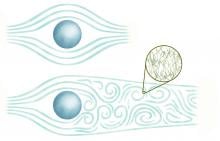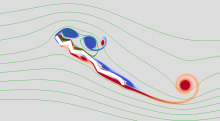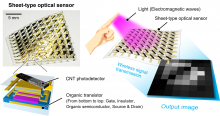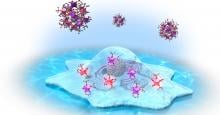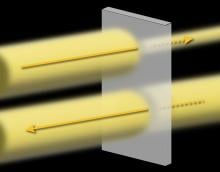Japan
News
22 Feb 2024
Researchers from Nano Life Science Institute (WPI-NanoLSI), Kanazawa University report in Nature Communications that TMEM16F, a transmembrane protein that facilitates the passive movement of phospholipids and ions across membranes, explores a larger conformational landscape than previously thought to perform its unique functions. The finding refines our molecular understanding of crucial physiological processes such as blood coagulation and COVID-19 pathogenesis, and highlights the importance of probing membrane proteins in native-like environments.
22 Feb 2024
The effects of a phenomenon called tree masting on ecosystems and food webs can be better understood thanks to new theoretical models validated by real world observations.
21 Feb 2024
Regenerative therapy to treat heart failure is more effective when the mitochondria of the regenerative cells are activated prior to treatment.
19 Feb 2024
In a study recently published in Nature Genetics, researchers from Nano Life Science Institute (WPI-NanoLSI), Kanazawa University explore chromatin accessibility, i.e., endogenous access pathways to the genomic DNA, and its use as a tool for gene editing.
16 Feb 2024
Researchers at Kanazawa University report in Journal of Cell Science on a novel role of the small Ca2+-binding protein S100A11 in focal adhesion disassembly.
16 Feb 2024
Researchers at Osaka Metropolitan University assess why post-operative symptoms such as pins and needles, sudden cold, burning, itching, and numbness in the limbs remain in patients suffering from cervical spondylotic myelopathy, even after surgery. The researchers also evaluated the patients’ satisfaction with postoperative treatment. They found that it was lower for those who still had paresthesia in their hands and feet, regardless of whether their motor symptoms had improved or not.
15 Feb 2024
Coordination polymer crystals show promise as a new generation of light sources for industry and medicine.
15 Feb 2024
A new method allows scientists to gather enough information about the properties of metals to enable the prediction of the properties of new materials.
15 Feb 2024
Researchers from Osaka University found that the oral bacterium Streptococcus gordonii activates another bacterial species, Fusobacterium nucleatum, to produce large quantities of methyl mercaptan, a compound responsible for bad breath. Disrupting this interaction could therefore help treat halitosis, and possibly also help prevent the development of more serious tooth and gum disease.
15 Feb 2024
Vaccines and therapies based on messenger RNA could be more readily delivered due to a non-toxic polymer that protects RNA and controls its release inside cells.
14 Feb 2024
Researchers from Osaka University and collaborating partners succeeded in biomanufacturing from chemically synthesized sugar for the first time in the world. With refinement of this technology, one can envision a future society in which the sugar required for biomanufacturing can be obtained "anytime, anywhere, and at high rate". In the future, biomanufacturing using chemically synthesized sugar is expected to be a game changer in the biotechnology field—including the production of biochemicals, biofuels, and food, where sugar is an essential raw material—ultimately leading to the creation of a new bio-industry.
14 Feb 2024
An innovative and more efficient way to produce fumaric acid that not only reduces carbon dioxide emissions, but also reuses waste resources to make biodegradable plastics
14 Feb 2024
Researchers from Osaka University have found that gargling with an antiseptic mouthwash can reduce so-called ‘bad’ bacteria in the mouths of patients with type 2 diabetes. Notably, this reduction in bacteria was accompanied by improved blood-sugar control in some patients. Given that the oral diseases caused by these bacteria have been linked to many other serious inflammation-associated diseases, such as cardiovascular disease and Alzheimer’s disease, this simple treatment may have widespread effects.
13 Feb 2024
The properties of supramolecular polymers are dictated by the self-assembled state of the molecules. However, not much is known about the impact of morphologies on the properties of nano- and mesoscopic-scale polymeric assemblies. Recently, a research team demonstrated how terminus-free toroids and random coils derived from the same luminescent molecule show different photophysical properties. The team also presented a novel method for purifying the toroidal structure.
13 Feb 2024
Researchers from the Institute of Industrial Science, The University of Tokyo have solved a foundational problem in transmitting quantum information, which could dramatically enhance the utility of integrated circuits and quantum computing.
13 Feb 2024
Researchers including Kavli IPMU have used equipment originally intended for astronomy observation to capture transformations in the nuclear structure of atomic nuclei, reports a study in Scientific Reports.
08 Feb 2024
A trained AI system learns to design cellular materials with specific target properties for a wide range of potential uses, including tissue engineering and energy storage.
08 Feb 2024
A new coating for tiny vaccine carriers allows vaccines to remain in the body for longer.
07 Feb 2024
Yokohama National University scientists are working towards creating a better tomorrow by addressing diverse challenges, from snow algae and tropical cyclones to AI cyberthreats, and much more.
01 Feb 2024
Theoretical predictions have been confirmed with the discovery of an outflow of molecular gas from a quasar when the Universe was less than a billion years old.
01 Feb 2024
Researchers from Osaka University and IMRA AMERICA demonstrated a 300 GHz-band wireless link that was able to transmit data over a single channel at a rate of 240 gigabits per second. The wireless communication system employs signal generators based on lasers that have ultra-low phase noise in the sub-terahertz band. This rate is the highest so far reported at these frequencies and is a substantial step forward in 300 GHz-band communications for 6G networks.
30 Jan 2024
A team of researchers from Osaka Metropolitan University assessed the feasibility of conducting cardiopulmonary exercise testing with the upper limbs as an alternative to the conventional method that uses the lower limbs. The researchers investigated the relationship between heart rate and oxygen uptake during exercise stress tests using a cycle ergometer and an arm crank ergometer, and estimated maximal oxygen uptake. The study participants were 17 male collegiate athletes from rowing and cycling clubs. The results showed that the estimated maximal oxygen uptake for both rowing and cycling groups was lower on the arm crank ergometer than on the cycle ergometer. Additionally, this study showed that exercise testing using an upper extremity ergometer underestimates cardiopulmonary function, regardless of upper limb training status.
29 Jan 2024
A new technology to increase visibility of cancer cells to the immune system using CRISPR has been developed, and could lead to a new way to treat cancer.
29 Jan 2024
A theoretical framework for measuring the Reynolds similitude in superfluids could help demonstrate the existence of quantum viscosity
23 Jan 2024
Corrugated wings exhibit larger lift than flat wings
23 Jan 2024
Researchers from SANKEN (The Institute of Scientific and Industrial Research), at Osaka University developed an optical sensor consisting of carbon nanotube photodetectors and organic transistors formed on an ultrathin, flexible polymer film. A wireless system reads the images from the sensor. Experiments showed the sensor has high sensitivity, a wide bandwidth, and robustness to extreme deformation such as bending and crumpling. This sensor has high potential for use in applications such as non-destructive imaging, non-sampling liquid quality evaluation, wearable devices, and soft robotics.
22 Jan 2024
A water-soluble, luminescent europium complex enables evaluation of malignancy grade in model glioma tumor cells.

19 Jan 2024
Temperature-controlled, reversible shifting of molecular gear motion in a solid crystal opens new possibilities for material design.
18 Jan 2024
A research group led by Osaka Metropolitan University has discovered significant nonreciprocal optical absorption of LiNiPO4, referred to as the optical diode effect, in which divalent nickel (Ni2+) ions are responsible for magnetism, by passing light at shortwave infrared wavelengths used in optical communications. Furthermore, they have uncovered that it is possible to switch the optical diode effect by applying a magnetic field. This is a step forward in the development of an innovative optical isolator that is more compact and can control light propagation, replacing the conventional optical isolators with complex structures
16 Jan 2024
Researchers from Osaka University have discovered a novel treatment to relieve cytokine release syndrome (CRS), a life-threatening inflammation triggered by a serious infection or severe burn. Treatment with a short-acting antibody reduces the inflammatory effects of interleukin-6, a key cytokine in CRS while avoiding the side effects associated with previous longer-acting therapies.
Events
17 Nov 2011
The conference will be held on 17th November to 18th November at Tianjin, P.R. China
09 Nov 2011
The conference will be held on 7th November 2011 to 10th November 2011 at International Convention Center (ICC), Jeju, Korea
07 Nov 2011
The conference will be held on 7th November 2011 to 10th November 2011 at DoubleTree Hotel San Jose, San Jose, CA, USA
11 Aug 2011
The conference will be held on 11th August 2011 to 12th August 2011 at Facultad de Ingeniería, Universidad de Buenos Aires, Buenos Aires, Argentina

09 Jun 2011
This year's symposium sets its theme as "Japan and the United States in Changing Asia" and discusses how Japan and the US,
in the context of China's emerging power and increasing debates on Asia integration, act in political financial and business fields and which direction Japan-US relationship should be searching for.
28 Nov 2011
The conference will be held on 28 November to 2 December at Pacifico Yokohama, Kanagawa, Japan.
22 Nov 2011
The conference will be held from 22-25 November at Ishikawa Ongakudo.
30 Oct 2011
The conference will be held on 30 October to 2 November in Sendai, Japan.
28 Sep 2011
The symposium will be held on 28-30 September at Le Meridien, Kota Kinabalu, Malaysia.
28 Aug 2011
The workshop will be held on 28-31 August at Nagaragawa Convention Center, Gifu, Japan.
22 Aug 2011
IFOST 2011 will be held on 22-24 August at Harbin University of Science and Technology, China.
21 Jun 2011
ICPST-28 will take place at Chiba University on the 21-24 June 2011.
30 May 2011
The 9th Japan / Korea International Symposium on Resources Recycling and Materials Science will take place at the Kansai University Centenary Memorial Hall from 30th May to 1st June 2011.
09 Nov 2011
The Japan Chapter of SAMPE is pleased to announce the 12th Japan International SAMPE Symposium and Exhibition (JISSE12) to be held from November 9 (Wed.) to 11 (Fri.) in 2007 at Tokyo Fashion Town Bldg., Tokyo.
19 May 2011
Conference Theme:
“Nanotechnology and Its Impact on Electron Devices”
- Successive Evolution of Electron Devices -
10 Mar 2011
The 4th IC-PLANTS is to be held at the Takayama Public Cultural Hall, Takayama JAPAN.

02 Mar 2011
An exhibition titled “Saneatsu and Red Porcelain” will be held in March and April at the Shigenori Tomioka Collection Gallery which opened in May 2009. This is an exhibition which takes the shape of word-association game-like concept linking Saneatsu Mushakoji to Naoya Shiga to Wanli red porcelain to five-colored Ming Dynasty porcelain.
18 Feb 2011
In the present symposium, cutting-edge nanotechnology R&Ds related to energy, environment, and resources issues are presented.

18 Jan 2011
Toyohashi University of Technology will host an International Symposium on "Quality Assurance and International Standards of Engineering Education" as following schedule.

03 Feb 2011
The first international symposium of the Strategic Exploitation of Neuro-Genetics for Emergence of the Mind program is to be held on 3 February 2011 in Tokyo, Japan.
02 Mar 2011
The MANA International Symposium, jointly held with International Center for Young Scientist (ICYS) is organized once a year to publish the research activities of MANA and ICYS.
17 Jan 2011
NIMS International Symposium on Photocatalysis & Environmental Remediation Materials 2011 will be held between the 17th and the 19th January 2011.

26 Nov 2010
International Cooperation in Engineering Education and its Effects upon Industrial Development - Achievements and Challenges -

24 Nov 2010
An international doctoral course between the RIKEN Yokohama institute Omics Science Center and Karolinska Institutet Department of Cell and Molecular Biology (Sweden) is to be held in November

24 Nov 2010
RIKEN Yokohama institute Omics Science Center and Karolinska Institutet Department of Cell and Molecular Biology (Sweden) are holding a joint international doctoral course on the subject “Functional Architecture of the Cell Nucleus”.

02 Jul 2010
Leading scientists to discuss developmental perspectives in vertebrate evolution

03 Jun 2010
It is our great pleasure to announce that Waseda University Organization for Japan-US Studies is holding the third international symposium “Japan, the United States, and China and Integration of East Asia: Conceptual Issues and Priorities”.

28 May 2010
While confusion deepens on the situation of the security treaties of Japan, the year 2010 brings the 50th year since the conclusion of the revised Japan-U.S. Security Treaty.

17 Mar 2010
Mita Logic Seminar "A Proof Theory Workshop (with Lecture Series by Grigori Mints)" is to be held as follows.
*Admission free, no registration required.
*This event will be held in English; no interpretation provided.
Researchers
Sorry, no researchers coming up for this topic.
Giants in history
Ruby Sakae Hirose (1904 – 1960) was a Japanese-American scientist whose research contributed significantly to our understanding of blood clotting, allergies and cancer.
Haisako Koyama (1916 – 1997) was a Japanese solar observer whose dedication to recording sunspots – cooler parts of the sun’s surface that appear dark – produced a sunspot record of historic importance.
Michiaki Takahashi (17 February 1928 – 16 December 2013) was a Japanese virologist who developed the first chickenpox vaccine.
Toshiko Yuasa (11 December 1909 – 1 February 1980) was the first Japanese female physicist whose research on radioactivity shed light on beta decay – the process in which an atom emits a beta particle (electron) and turns into a different element.
Baron Kitasato Shibasaburo (29 January 1856 – 13 June 1931) was a Japanese physician and bacteriologist whose work led to a new understanding of preventing and treating tetanus, diphtheria and anthrax.
By isolating soil microorganisms and studying the compounds they produce, Satoshi Omura (born 1935) discovered almost 500 organic compounds with unique properties that were produced by these microorganisms, including many new antibiotics.
In 1915, pathologist Katsusaburo Yamagiwa and his research assistant Koichi Ichikawa became the first to prove that chronic exposure to chemicals can cause cancer.
In 1915, Koichi Ichikawa along with pathologist Katsusaburo Yamagiwa became the first to prove that chronic exposure to chemicals can cause cancer.
Reiji Okazaki (8 October 1930 – 1 August 1975) and Tsuneko (7 June 1933) were a Japanese couple who discovered Okazaki fragments – short sequences of DNA that are synthesized during DNA replication and linked together to form a continuous strand.
Tsuneko (7 June 1933) and Reiji Okazaki (8 October 1930 – 1 August 1975) were a Japanese couple who discovered Okazaki fragments – short sequences of DNA that are synthesized during DNA replication and linked together to form a continuous strand.
Husband and wife team, Kimishige (3 December 1925 – 6 July 2018) and Teruko Ishizaka (28 September 1926 – 4 June 2019) discovered the antibody class Immunoglobulin E (IgE) that triggers allergic reactions. They also discovered that IgE antibodies attach to white blood cells, known as mast cells, releasing histamine, which causes allergic reactions.
Husband and wife team, Kimishige (3 December 1925 – 6 July 2018) and Teruko Ishizaka (28 September 1926 – 4 June 2019) discovered the antibody class Immunoglobulin E (IgE) that triggers allergic reactions. They also discovered that IgE antibodies attach to white blood cells, known as mast cells, releasing histamine, which causes allergic reactions.
Japanese chemist Takamine Jokichi (3 November 1854 – 22 July 1922) founded the Tokyo Artificial Fertilizer Company, where he isolated a starch-digesting enzyme (named takadiastase) from the fungus Aspergillus oryzae.
Hideki Yukawa (23 January 1907 – 8 September 1981) was awarded the Nobel Prize in Physics in 1949 for predicting the existence of the pi meson subatomic particle. Japan’s first Nobel laureate, Yakawa also expressed his support for nuclear disarmament by signing the Russell–Einstein Manifesto in 1955.
Shinichiro Tomonaga (31 March 1906 – 8 July 1979), together with Richard Feynman and Julian Schwinger, was awarded the Nobel Prize in Physics in 1965, for their contributions to advance the field of quantum electrodynamics. Tomonaga was also a strong proponent of peace, who actively campaigned against the proliferation of nuclear weapons and promoted the peaceful use of nuclear energy.
Japanese chemist Kenichi Fukui (4 October 1918 – 9 January 1998) was the first Asian scientist to be awarded the Nobel Prize in Chemistry. Together with Roald Hoffman, he received this honour in 1981 for his independent research into the mechanisms of chemical reactions.
Minoru Shirota (April 23, 1899 – March 10, 1982) was a Japanese microbiologist who invented the popular fermented drink Yakult.
Japanese physicist Ukichiro Nakaya (1900-1962) made the world’s first artificial snowflakes. He started his research on snow crystals in the early 1930s at Hokkaido University, where there is an unlimited supply of natural snow in winter. By taking over 3,000 photographs, he established a classification of natural snow crystals and described their relationship with weather conditions.
The techniques that make industrial pearl culturing possible were developed over a century ago at the Misaki Marine Biological Station in Japan. The station’s first director, Professor Kakichi Mitsukuri, emphasized to Kokichi Mikimoto in 1890 that stimulating pearl sac formation was important for pearl growth, and they went on to successfully develop methods for culturing pearls.
The field of solid-state ionics originated in Europe, but Takehiko Takahashi of Nagoya University in Japan was the first to coin the term ‘solid ionics’ in 1967. ‘Solid-state ionics’ first appeared in 1971 in another of his papers, and was likely a play on ‘solid-state electronics’, another rapidly growing field at the time.
Chika Kuroda (24 March 1884 – 8 November 1968) was a Japanese chemist whose research focussed on the structures of natural pigments.
Motoo Kimura (13 November 1924 – 13 November 1994) was a Japanese theoretical population geneticist who is best remembered for developing the neutral theory of molecular evolution.
Osamu Shimomura (27 August 1928 – 19 October 2018) was a Japanese organic chemist and marine biologist who dedicated his career to understanding how organisms emitted light.
Kikunae Ikeda (8 October 1864 – 3 May 1936) was a Japanese chemist who discovered the fifth basic taste, umami.
Umetaro Suzuki (7 April 1874 – 20 September 1943) was a Japanese scientist best remembered for his research on beriberi, a disease caused by vitamin B1 deficiency, characterized by limb stiffness, paralysis and pain.
Kono Yasui (16 February 1880 – 24 March 1971) was a Japanese botanist who researched the genetics of poppies, corn and spiderworts and surveyed the plants that had been affected by the nuclear fallout after the atomic bombings of Hiroshima and Nagasaki.
Hitoshi Kihara (1893 – 1986) was one of the most famous Japanese geneticists of the 20th century. One of his most significant contributions was identifying sex chromosomes (X and Y) in flowering plants.
Michiyo Tsujimura (17 September 1888 – 1 June 1969) was a Japanese agricultural scientist and biochemist recognized for her research of green tea components.
A Japanese surgeon, Tetsuzo Akutsu (20 August 1922 – 9 August 2007) built the first artificial heart capable of keeping an animal alive.
Ogino Ginko (3 March 1851 – 23 June 1913) was the first registered female doctor to practise modern medicine in Japan.
Japanese geochemist Katsuko Saruhashi developed the first method and tools for measuring carbon dioxide in seawater


